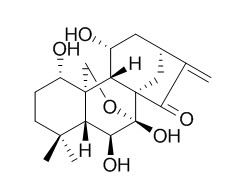Effusanin E
Effusanin E shows antibacterial and anti-cancer activities, it significantly inhibits cell proliferation and induces apoptosis in NPC cells by suppressing p50/p65 proteins to down-regulate COX-2 expression .
Inquire / Order:
manager@chemfaces.com
Technical Inquiries:
service@chemfaces.com
Tel:
+86-27-84237783
Fax:
+86-27-84254680
Address:
1 Building, No. 83, CheCheng Rd., Wuhan Economic and Technological Development Zone, Wuhan, Hubei 430056, PRC
Providing storage is as stated on the product vial and the vial is kept tightly sealed, the product can be stored for up to
24 months(2-8C).
Wherever possible, you should prepare and use solutions on the same day. However, if you need to make up stock solutions in advance, we recommend that you store the solution as aliquots in tightly sealed vials at -20C. Generally, these will be useable for up to two weeks. Before use, and prior to opening the vial we recommend that you allow your product to equilibrate to room temperature for at least 1 hour.
Need more advice on solubility, usage and handling? Please email to: service@chemfaces.com
The packaging of the product may have turned upside down during transportation, resulting in the natural compounds adhering to the neck or cap of the vial. take the vial out of its packaging and gently shake to let the compounds fall to the bottom of the vial. for liquid products, centrifuge at 200-500 RPM to gather the liquid at the bottom of the vial. try to avoid loss or contamination during handling.
Molecular & Cellular Toxicology2022, 10.1007:s13273-022-00277-3
Int Immunopharmacol.2021, 100:108073.
Journal of Apiculture2023.38(3):249-254.
Food Chem. 2020, 320:126530
Food Science.2023, 4(20):268-282.
Molecules.2023, 28(3):958.
Biomol Ther (Seoul).2023, 31(1):40-47.
Planta Med.2018, 84(15):1101-1109
Phytomedicine.2023, 116:154841.
Int J Mol Sci.2023, 25(1):283.
Related and Featured Products
PLoS One. 2014 Oct 21;9(10):e109951.
Effusanin E suppresses nasopharyngeal carcinoma cell growth by inhibiting NF-κB and COX-2 signaling.[Pubmed:
25333664]
Rabdosia serra is well known for its antibacterial, anti-inflammatory and antitumor activities, but no information has been available for the active compounds derived from this plant in inhibiting human nasopharyngeal carcinoma (NPC) cell growth.
METHODS AND RESULTS:
In this study, we isolated and purified a natural diterpenoid from Rabdosia serra and identified its chemical structure as Effusanin E and elucidated its underlying mechanism of action in inhibiting NPC cell growth. Effusanin E significantly inhibited cell proliferation and induced apoptosis in NPC cells. Effusanin E also induced the cleavage of PARP, caspase-3 and -9 proteins and inhibited the nuclear translocation of p65 NF-κB proteins. Moreover, Effusanin E abrogated the binding of NF-κB to the COX-2 promoter, thereby inhibiting the expression and promoter activity of COX-2. Pretreatment with a COX-2 or NF-κB-selective inhibitor (celecoxib or ammonium pyrrolidinedithiocarbamate) had an additive effect on the Effusanin E-mediated inhibition of proliferation, while pretreatment with an activator of NF-κB/COX-2 (lipopolysaccharides) abrogated the Effusanin E-mediated inhibition of proliferation. Effusanin E also significantly suppressed tumor growth in a xenograft mouse model without obvious toxicity, furthermore, the expression of p50 NF-κB and COX-2 were down-regulated in the tumors of nude mice.
CONCLUSIONS:
These data suggest that Effusanin E suppresses p50/p65 proteins to down-regulate COX-2 expression, thereby inhibiting NPC cell growth. Our findings provide new insights into exploring Effusanin E as a potential therapeutic compound for the treatment of human nasopharyngeal carcinoma.
Food Chem. 2013 Aug 15;139(1-4):902-9.
Antibacterial activity-guided purification and identification of a novel C-20 oxygenated ent-kaurane from Rabdosia serra (MAXIM.) HARA.[Pubmed:
23561188 ]
The objective of this work was to conduct an activity-guided isolation of antibacterial compounds from Rabdosia serra.
METHODS AND RESULTS:
The ethanol extracts of R. serra leaf and stem were partitioned sequentially into petroleum ether, ethyl acetate, butanol and water fractions, respectively. The ethanol extract of leaf evidenced broad-spectrum antibacterial activity against gram-positive bacterial, including Bacillus subtilis, Bacillus cereus, Staphylococcus aureus, and Listeria monocytogenes. The ethyl acetate fractions of leaf and stem exhibited strong inhibition against gram-positive bacteria, and were then purified further. On the basis of antibacterial assay-guided purification, three phenolic compounds (rosmarinic acid, methyl rosmarinate and pedalitin) and four C-20 oxygenated ent-kauranes (Effusanin E, lasiodin, rabdosichuanin D and a new compound namely effusanin F) were obtained, whose contents were determined by HPLC analysis.
CONCLUSIONS:
The broth microdilution method confirmed the important inhibition potential of C-20 oxygenated ent-kauranes with low minimum inhibitory concentration (MIC) values. Effusanin E, lasiodin and effusanin F could be useful for the development of new antibacterial agents.



